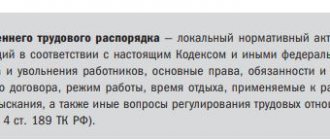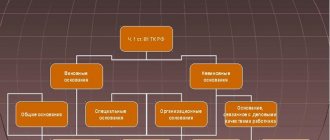Basic rights of an employee
When hired, a citizen enters into an employment contract with the employer. This is an agreement that reflects essential and additional terms. Without essential conditions, a contract cannot be recognized as legal, therefore their reflection in its text is mandatory. The essential conditions are:
- term;
- salary;
- functions performed by the employee;
- place of work.
The absence of additional conditions for legal consequences does not lead to the illegality of the transaction. But, as a rule, they are still included in the text, since they help to better understand the essence of the relationship between the parties. The basic rights and responsibilities of an employee are determined by Art. 21 Labor Code of the Russian Federation:
- conclusion, modification, termination of a contract with an employer;
- receipt of wages in full, other payments not included in it;
- workplace agreed upon by the terms of the agreement;
- vacation;
- reliable, up-to-date information regarding wage conditions;
- participation in trade unions, their creation in the organization;
- protection of labor rights;
- compulsory insurance;
- compensation for damage caused by the employer.
This list of rights (not closed) applies to employees of the organization.
Tasks of labor standardization
Actually, why do enterprises introduce various types of labor standards? As experts note, this practice is aimed, first of all, at ensuring that the employee can effectively realize his potential. In general, this means that with a minimum amount of time, a person must ensure the production of as large a volume of products as possible with sufficient quality of the products. Labor standardization is also important from the point of view of protecting workers from excessive workloads. It is assumed that compliance with labor standards in optimal volumes presupposes a rational and reasonable intensity of human participation in production processes.
It often happens that an enterprise experiences a shortage of personnel in one or another area of work. This is not such a rare case when there may be more vacancies than applicants. It happens that several enterprises directly compete for the right to hire a particular employee with the required qualifications. Staffing is also one of the most important tasks for any enterprise.
And in this case, one of the competitive factors may be not so much ensuring the realization of a specialist’s potential, but rather creating attractive working conditions for him in the company. There is such a thing as social labor standards. In one interpretation, it can be understood as the definition of criteria aimed at providing incentive support for employees according to indicators established at the enterprise, which, if two enterprises compete for one employee, can become an additional factor in the specialist’s loyalty to his employer.
Thus, an enterprise must be prepared to comply not only with working conditions established at the level of laws or industry standards. In some cases, tasks associated with staffing may require the introduction of a wide range of corporate employee support programs, providing both financial incentives and, for example, maintaining psychological comfort during the work process.
Main responsibilities of the employee
If an employee is endowed with rights, then he also has responsibilities. They are:
- compliance with labor laws;
- compliance with labor safety standards;
- conscientious performance of labor duties;
- compliance with labor standards;
- careful handling of property owned by the employer.
In addition, the employee’s responsibility in the field of labor law is to comply with internal labor regulations.
2.4. Work and play
Labor is an activity that distinguishes humans from animals. It was labor, according to F. Engels, that contributed to the formation of man as a social being.
Labor activity manifests itself in various spheres of human life. He works at work, at home, at his dacha, etc. Depending on the result, labor is divided into productive and unproductive. Productive labor is associated with the creation of a variety of material objects. For example, a person works in a factory, producing parts that are then assembled into a product (TV, vacuum cleaner, car, etc.). At the end of the working day, he comes home, cooks food and devotes his free time to his favorite activity (hobby), for example, assembling a radio, carving figurines from wood, etc. On weekends in the summer at his dacha, he cultivates a vegetable garden and harvests in the fall. These are all examples of productive work.
Unproductive labor is aimed not at creating, but at servicing material objects. In the economic sphere, unproductive labor is associated with the provision of services: transportation of goods, their loading, warranty service, etc. In the domestic sphere, unproductive labor includes cleaning the apartment, washing dishes, home repairs, etc.
Both productive and unproductive labor are equally important. If there was only the production of industrial products, but no repair services, then landfills would be filled with broken household appliances, cars, furniture, etc. Why buy a new thing if it makes more sense to repair the old one?
But humanity creates not only material objects. It has accumulated enormous cultural experience, embodied in literature, science, and art. How to classify this type of work? In this case, they talk about intellectual work or spiritual production. To distinguish this type of labor, a special classification was required, namely, the division of labor into mental and physical.
For many centuries of its history, humanity knew mainly only physical labor. Many works were carried out using human muscle power. Sometimes humans were replaced by animals. Mental work was the prerogative of monarchs, priests and philosophers.
With the development of science and technology, the advent of machines in industrial production, physical labor was increasingly replaced by mental labor. The share of workers engaged in mental work has constantly increased. These are scientists, engineers, managers, etc. In the 20th century. It is not without reason that people started talking about the objective merging of mental and physical labor. After all, even the simplest work now requires a certain amount of knowledge.
This is important to know: Order on the appointment of a senior crew
Nature gives us very little in finished form. Without labor, you cannot even pick mushrooms and berries in the forest. In most cases, natural materials undergo complex processing. Thus, labor activity is necessary in order to adapt the products of nature to human needs.
Satisfaction of needs is the goal of work activity. It is necessary to realize not only the need itself, but also to comprehend the ways to satisfy it and the efforts that need to be made for this.
To achieve the goals of work, various means are used. These are various tools of labor adapted to perform a particular job. When starting any work, you need to know exactly what tools are needed at the moment. You can dig up a garden at your dacha with a shovel, but the field cannot be plowed without the use of special equipment. You can dig a hole for a long time with the same shovel, or you can do it in a few minutes with an excavator. Thus, you need to know the most effective ways to influence the object of labor, i.e. to what undergoes transformation in the process of labor activity. Such methods of influencing the object of labor are called technologies, and the set of operations to transform the initial product into the final product is called a technological process.
The more advanced tools and the more correct technology are used, the higher labor productivity will be. It is expressed in the quantity of products produced per unit of time.
Each type of work activity consists of separate operations, actions, and movements. Their nature depends on the technical equipment of the labor process, the qualifications of the worker, and, in a broad sense, on the level of development of science and technology. In our time of scientific and technological progress, the level of technical equipment of labor is constantly increasing, but this does not exclude the use of human physical labor in some cases. The fact is that not all labor operations can be mechanized. The technology is not always applicable when loading and unloading goods, during construction, assembling the final product, etc.
Labor activity, depending on its nature, goals, effort and energy, can be individual and collective. The individual work of a craftsman, a housewife, a writer and an artist. They independently carry out all labor operations until the final result is obtained. In most cases, labor operations are, one way or another, divided between individual subjects of the labor process: workers at a factory, builders at a house, scientists at a research institute, etc. Even initially seemingly individual work activities can represent part of the totality of work operations of many people. So, to improve the land, a farmer buys fertilizers produced by other people, and then sells the crop through wholesale centers. This situation is called specialization, or division of labor. For a more effective organization of the labor process, communication between its participants is necessary. Through communication, information is transmitted and joint activities are coordinated.
The concept of “labor” is synonymous with the concept of “work”. In a broad sense they are indeed the same. However, if we can call work any activity to transform the surrounding reality and satisfy needs, then work is most often called activity that is carried out for remuneration. Thus, work is a type of work activity.
The increasing complexity of work activity and the development of new types of work have led to the emergence of many professions. Their number is increasing more and more with the development of science and technology. A profession is a type of work activity with a specific nature and purpose of work functions, for example, a doctor, teacher, lawyer. The presence of special, more in-depth skills and knowledge in a given profession is called a specialty. Even at the stage of training in a specialty, specialization can be carried out, for example, a surgeon or general practitioner, a physics teacher or a mathematics teacher, etc.
But it is not enough to have a specific specialty. You need to gain practical skills for working on it. The level of training, experience, and knowledge in a given specialty is called qualification. It is determined by rank or rank. Discharges exist among workers at industrial enterprises and among school teachers. Titles are awarded to figures in science and higher education.
The higher the qualifications of the employee, the higher his work is paid. If he changes jobs, it is easier for him to find a better place. If they say about a person: “This is a highly qualified worker, a professional in his field,” then they mean the high quality of the work he performs. Professionalism requires the employee to do more than just mechanically follow the instructions of the manager. Having received an order, a person must think about how best to carry it out. It is impossible to provide for all situations that arise in the labor process in rules, orders, and instructions. The employee must find the optimal solution that allows him to fulfill the assignment given to him efficiently and on time. This creative approach to completing tasks is called initiative.
Any work activity, be it chopping wood in the country or performing complex production processes in a factory, requires the implementation of special rules. Some of them are related to the technological process, i.e. consistency and correctness of all labor operations performed by the employee. Others are based on compliance with safety regulations. Everyone knows that you should not disassemble electrical appliances unless they are disconnected from the power supply, make fires near wooden buildings, drive a car with a faulty engine cooling system, etc. Failure to comply with such rules can lead to both the breakdown of an item that has been improperly used and harm to human life and health. But a person’s work activity often takes place in a team, and failure to comply with equipment operating standards and safety regulations can harm the health of other people.
Working conditions play a major role in the labor process. These include workplace equipment, noise level, temperature, vibration, room ventilation, etc. Particularly harmful, extreme working conditions cause severe occupational diseases, major accidents, serious injuries and even death.
During the period of formation and development of industrial production, the worker began to be considered, along with machines, as part of the production process. This approach excluded initiative in the performance of work duties. Workers felt that they were being dominated as individuals by machines. They developed a negative attitude towards work as something forced, performed only when necessary. This phenomenon of industrial production is called the dehumanization of labor.
Currently, the problem of humanization of labor has arisen, i.e. his humanization. It is necessary to eliminate factors that threaten human health. First of all, it is necessary to replace heavy, monotonous physical labor with the work of machines. It is necessary to prepare educated, comprehensively developed workers who are capable of a creative approach to the labor functions they perform; increase the level of work culture, i.e. improve all components of the labor process (working conditions, relationships between people in the team, etc.). An employee should not be confined to the narrow scope of the labor functions he performs. He should know the content of the labor process of the entire team, understand the features of production at the theoretical and technological level. Only in this case will work become the basis for a person’s self-realization.
This is important to know: Legal acts regulating the work activities of people with disabilities
The opposite of work activity is leisure activity. Lawyers call all free time from work rest time. This does not mean that during such periods a person does nothing. He can work, doing housework, he can go for a walk or go on a trip. All these ways of spending free time involve taking active actions. One of these actions is a game.
Game activity, unlike work activity, is focused not so much on the result as on the process itself. Games arose in ancient times and were associated with religion, art, sports, and military exercises. Scientists will probably never figure out how games originated. Perhaps they emerged from the ritual dances of ancient people, or perhaps they were a way of teaching the younger generation.
Proponents of the theory of the biological origin of play believe that games are characteristic of many animals and are based on instincts. For example, during games, young animals learn the behavior patterns of representatives of their species, and mating games help attract a partner. The opposite point of view is that play is a specific human activity.
If we consider play as a type of human activity, then we can say that it is more characteristic of children. With the help of games, children learn, communicate, learn something new, and develop their mental and physical abilities. There are many types of games: with objects, plot, role-playing, movement, educational, sports, etc. As a person gets older, the number of games in his life decreases. Some disappear completely, remaining as childhood memories, others are replaced by sports and art. New types of “adult” games are appearing, primarily gambling: cards, slot machines, casinos, etc. Excessive passion for them often leads to serious consequences: a player can lose all his property, leave his family without a livelihood, and even commit suicide.
The uniqueness of play activity, especially in childhood, is most evident in its two-dimensionality. The player performs real actions, although they are conditional, allowing him to act in an imaginary environment. It is no coincidence that during the game, children utter the words “as if,” emphasizing that the situation is fictitious.
The distribution of roles plays an important role in the game. Each of the players strives to take the main, best role. There may not be enough such roles for all participants. Therefore, the game teaches loyalty and compromise even at the stage of its preparation.
The implementation of role functions is associated with the transformation of the player into an imaginary hero. Moreover, the entire course of the game is based on the implementation of certain rules, the same for all participants. The game can use various objects, symbols, gestures, and conventional signs. Often specific situations are modeled, which helps to include the child in the world of human relationships and teaches adult life. Some types of games develop mental activity, instill perseverance, patience, i.e. those qualities that will be useful during study, and then in the process of work.
There is no doubt about the relationship between work and play. Some games, especially educational ones, involve the need to exert certain efforts, and in work activities one can find game elements. “Does it effortlessly,” they say about masters of their craft, i.e. makes it easy, relaxed, highly professional.
1. How did labor influence the processes of anthropo- and sociogenesis?
2. In what areas of a person’s life and how is labor activity manifested?
3. What are the differences between productive and unproductive labor?
4. What is intellectual work? What is the relationship between mental and physical labor?
5. What are the goals of work? How are subject, object and tools interconnected?
6. What role does specialization play in work activity?
7. Explain the concepts of profession, specialty, qualification.
8. Who are called professionals? What is meant by professionalism? Give examples of professionalism.
9. What rules must be followed during work? Why is their implementation necessary?
10. What is the problem of humanization of labor?
11. What are the differences between work and play? What role does play play in a person’s life?
12. What labor issues are raised in the following statements:
A.P. Chekhov: “You must put your life in such conditions that work is necessary. Without work there cannot be a pure and joyful life.”
F. W. Taylor: “Everyone must learn to abandon his individual methods of work, adapt them to a number of newly introduced forms, and get used to accepting and executing directives concerning all small and large methods of work, which were previously left to his personal discretion.”
J.V. Goethe: “Every life, every activity, every art must be preceded by a craft, which can only be mastered with a certain specialization. Acquiring complete knowledge, complete skill in the field of one subject provides more education than mastering half a hundred different subjects.”
L.N. Tolstoy: “Corporal labor not only does not exclude the possibility of mental activity, not only does not humiliate its dignity, but also encourages it.”
I.P. Pavlov: “All my life I have loved and love mental and physical work, and, perhaps, even more than the second. I especially felt satisfied when I contributed some good guess to the last one, i.e. connected “head with hands.”
Internal labor regulations
The protection of internal labor regulations is carried out by the employer. According to Art. 189 The Labor Code of the Russian Federation, internal labor regulations, is a local regulatory act that is subject to the Labor Code of the Russian Federation and other federal laws.
Internal labor regulations are a document that regulates the procedure for hiring and leaving the organization’s employees, their powers, responsibilities, rest and work schedules, incentives, penalties, as well as other issues related to labor relations.
As a rule, this document is an annex to a collective labor agreement, or less often to an individual employee’s contract. The provision that the employee has these rules when concluding a contract is not a mandatory provision. But every employee working at the enterprise must be familiar with the rules.
Motivation
Motivation is the basis of human behavior. It is a system of factors that reflect a person’s goals and needs, his intentions, show his interests and established values, and his attitude towards others. Directed and active behavior of a person determines his motivation.
This is important to know: Order banning smoking on the premises of the enterprise (sample 2020)
Specific actions and actions of a person are influenced by a phenomenon called motive. Motive determines the physical and mental state of a person at the time of his actions in dangerous or standard situations. It is a “detonator” of human actions.
The formation of a motive can occur in different ways. It can arise from an unconscious decision and cause impulsive and thoughtless behavior. A motive formed with a conscious decision allows you to weigh and evaluate the situation if a person behaves correctly. The model presented by the brain that determines goals, actions and methods of implementation can figuratively be called a motive. Motivation is not a permanent quality of a person. It is subject to constant renewal and change throughout a person’s life path. The motives for his actions will depend on the results of his upbringing, education, and life experience.
The formation of motivation is influenced by psychological attitudes and human needs. The state of a person that determines his feelings of having something or someone is a need.
The famous psychologist A. Maslow in his concept identified five groups of human needs:
- physiological;
- safety;
- affiliation (striving to belong to a certain social group)
- recognition (achieving heights of skill, high social status, prestige and competence);
- self-realization (cognition and aesthetics).
The formation of each of the needs, starting with the second group, occurs when the previous one is satisfied.










